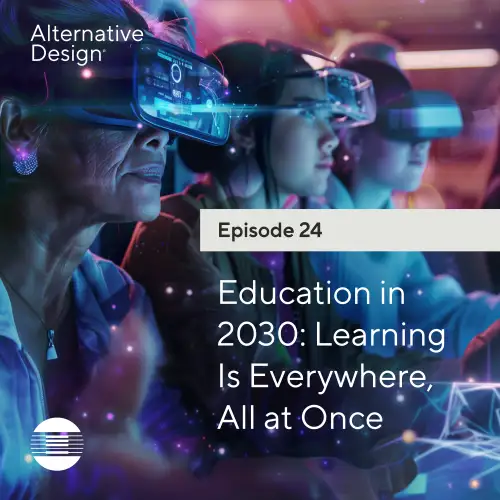LEARNING IS EVERYWHERE, ALL AT ONCE
It’s 2030, and education is as integral to your daily routine as scrolling through your social media feed. The term "student" has expanded its definition, applying not just to the young but to anyone (at any age) engaged in formal learning. Which is just about everyone. Continuous, credentialed learning has fragmented the traditional linear education model, making it more affordable and more accessible for many walks of life.
With the help of artificial intelligence, education is more personalized than ever, based on an individual’s unique learning style, aptitude, and even personality. Some universities have capitalized on this by offering tuition fees as a low-cost monthly subscription, which many learners have taken advantage of due to the need to upskill to stay current in today’s labor market. Rather than amounting to a small paragraph on a resume, education experience is now a “learning portfolio” where hiring managers expect to see a diverse range of skills and experience-based learning that’s assessed and verified with blockchain technology. Even some vacations can qualify as an experiential credit that shows language, navigation, and cultural literacy skills.
THE NEW WORK-LIFE BALANCE: "LIVE. WORK. LEARN."
Lifelong learning was adopted on the heels of the “Live. Work. Learn.” model that was popularized in the mid-2020s. Ushered in by Gen Alphas who sought the same level of flexibility and work-life balance their parents experienced during the COVID-19 pandemic, many learning workers adopted a well-being first approach. Leveraging AI mentors to suggest what to prioritize and when, they balanced living, working, and learning.
Younger students, some as young as 10, are now gaining a valuable head start to their careers with curriculum that’s geared toward required knowledge and skills for professions they show interest in. They can also begin to test drive different aspects of corporate culture, like delivering a sales pitch, through immersive technologies. This not only demystifies the professional environment, but also helps in the development of “soft skills” like teamwork, problem solving, and assertiveness. With AI automation taking some of the administrative burdens off teachers, many have found they have more time to create evergreen learning content for various media platforms, creating compensation for their intellectual labor. The “Instructor Influencer Economy” on platforms like YouTube and Coursera offers larger earning potential for teachers. Additionally, for tenured professors, the option of a flexible work schedule has become increasingly attractive. Many now choose to facilitate in-person learning sessions on campus three days a week and spend the remainder consulting for businesses. These consultations aim to tailor educational content that better prepares students for the workforce.
THE THIRD PLACE EVOLUTION
As education became increasingly integral to daily life, whether for learning portfolios or for pleasure, unlikely spaces became learning hubs. In the mid-2020s tech giants like Apple began offering coding bootcamps right in their storefronts while clothing retailers like H&M offered fashion design workshops that taught participants about sustainable materials and manufacturing. Temporary educational installations in public spaces like parks, malls, and squares, offered short, immersive learning experiences. These pop-ups use interactive technology and gamification to teach about environmental conservation, history, and even basic health principles, turning everyday spaces into opportunities for discovery and growth. And now, many coffee shops, restaurants, hotels, and bars are piloting university-branded “Edu-Pods” that bring learning to the third place. Universities partner with local furniture dealerships to rent out these fully equipped solo or group pods that feature immersive learning technologies. Students or learning workers can swipe their university identification and have access to short learning burst modules or continue an experiential course offering.
UNIVERSITIES AS LANDLORDS
To take advantage of the new “Live. Work. Learn.” model, some traditional university campuses have transformed to facilitate new partnerships between businesses and higher education institutions. Many businesses, challenged with what to do once their leases were up in their corporate office spaces, chose to relocate to mixed-use neighborhoods. Others saw value in moving closer to the talent funnel and began leasing space from universities, which had surplus classroom and admin space because of the increase in hybrid learning offerings. In addition to proximity to up and coming and renewed talent, universities created better access to learning workers to those who leased space from them.
POPULAR CAMPUS SPACES ARE REIMAGINED
The partnership between colleges and businesses changed the dynamic of the “on-campus experience” in several key ways. Many libraries, once quiet havens of books and study, have now turned into technology upskilling centers where lifelong learners can access state-of-the-art equipment and attend workshops on how to use them for both personal and business use. Student Centers are transitioning into community venues, utilizing transformable furnishings to cater to a variety of student groups and corporate teams needing a place to meet in person. Even though many social clubs, even Greek life, have transitioned into online communities, large campuses often host regional bi-annual club gatherings that draw students nationwide. But perhaps the biggest draw is for eSports tournaments, particularly for the “Climate Conquest League” where learners of all ages use prompts to model design and engineering solutions for global challenges related to food scarcity, climate migration, and more.
With many student centers becoming destinations by design, acting as gathering places for multiple groups, nearby hotels have started struggling to meet the demand for stay accommodations. College campuses that shifted to a hybrid-first approach were some of the first to offer former dormitories as “Edu-Stay Suites”. Other universities are transforming outdated dormitories into boutique hotels that blend modern comforts with the nostalgic charm of a college residence, aimed at guests participating in “micro-sabbaticals”. A modern version of a traditional “gap year” with a regenerative tourism twist, a “micro-sabbatical” is a way for students and learning workers to seamlessly blend both rest and education. Guests may start their day with a community breakfast, featuring a talk from a local historian, and by the afternoon volunteer in a university-affiliated program. This could be working on a collaborative community project that taps into their unique expertise and involves hands-on activities in areas like rewilding, climate resilient housing, or helping a tech startup incubator. In the evening, wellness workshops or classes may be available followed by access to well-being amenities before going to sleep. The goal is for the guest to leave not only refreshed but also having made a positive impact on the local community, both at the university and beyond.



